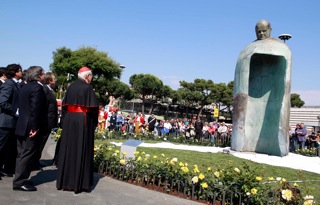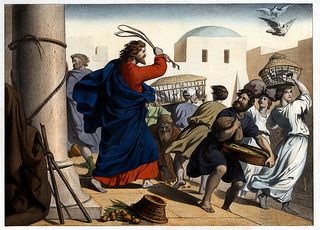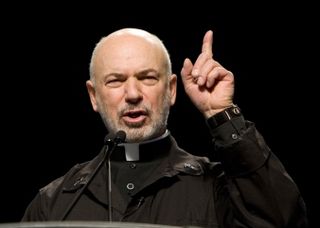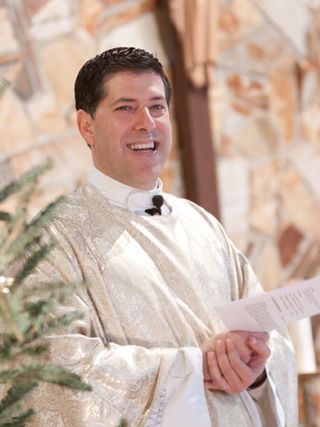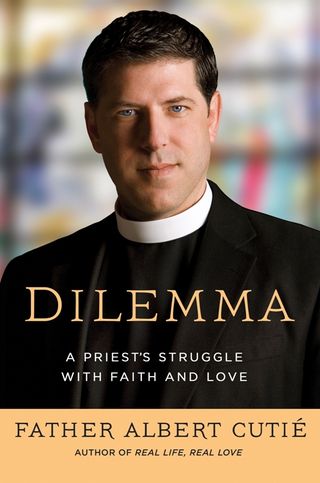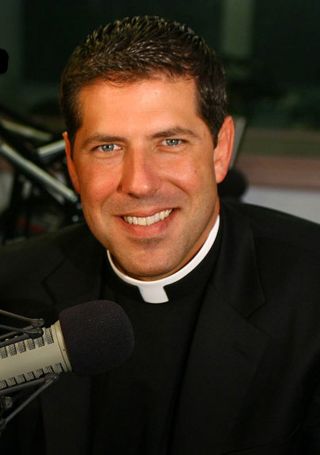Archbishop Gregory Aymond of New Orleans said that a local Catholic school must permanently ban corporal punishment for student misbehavior, even though many parents and alumni support the practice. …
Since 1951 teachers and administrators at the historically black all-boys school have used an 18-inch-long wooden paddle, known as “the board of education,” to administer punishment to students for tardiness, sloppy dress or other minor infractions.
However, Archbishop Aymond and Josephite superior general Fr. Edward Chiffriller, who heads the school’s board of trustees, ordered an end to the practice.
A town hall meeting assembled to discuss the change attracted an audience that numbered over 600 and included current students from grades six to 12, current and former parents, grandparents, benefactors and friends of the school.
“Board of education.” Heh. Definite points for that.
Personally, I do not have an opinion on whether corporal punishment should be administered at St. Augustine High School—the school in question. My own conviction is that the issue of corporal punishment is one for parents to decide. I have known some parents who have successfully raised children using it seldom or never. I also know there are parents who feel it is has played an important and needed role in raising their children. The fact is that children are different, and some respond to different things. To one child a time out may be far more agonizing (and motivating) than a paddling. To others just the reverse will be the case. Whether corporal punishment is to be used in the case of their own children—and how much and when—is something that I view as within the natural law rights of the parents.
Because of that, I can see why a school might choose not to have corporal punishment on campus, simply in respect of the rights of parents who do not wish it administered to their children (quite apart from issues of lawsuits and such). I can also see a school having a policy of allowing corporal punishment for those children whose parents do not object to it (such a policy could be a little tricky, but doable). And I can see a school saying, “It is our policy to use corporal punishment in disciplinary cases. If you have a problem with that policy, feel free to place your children with another school that has a different policy.”
So, I don’t have a problem with schools taking different policy positions on this, just as I don’t have a problem with parents doing so. I think reasonable people can have a legitimate diversity of opinion.
I also don’t have a problem with Archbishop Aymond deciding not to have corporal punishment at St. Augustine. As the local bishop, that’s within his purview.
I would, however, offer some thoughts on some of the claims made in the CNA story. I have to say that I wasn’t at the town hall meeting, and so I don’t know exactly what was said or in what context, but based on the coverage provided by CNA, several things leapt out at me:
Corporal punishment can cause unintended physical injury and studies indicate it can cause physical, emotional and psychological damage, including loss of self-esteem and increased hostility toward authority, the archbishop said.
I couldn’t blame the parents at the town hall meeting who may have questioned this kind of claim. While scientific studies can tell us many useful things, something like a third of them turn out to be wrong, and they can often be skewed by the agendas of the scientists who perform them. There have been all kinds of social science and psychological studies that have been “cooked” to support claims like abortion doesn’t leave lasting emotional damage, divorce doesn’t really hurt the children, homosexual couples are just as capable of being good parents, etc., etc. The anti-corporal-punishment movement intersects in a significant way with the same constellation of agendas that has cooked the studies just named. It is not much of a stretch of the imagination to suppose that anti-spanking studies have been similarly cooked.
That’s not to say that they’re automatically wrong. They could be right. This is an empirical question, and the solution cannot be decided in advance. If reliable studies have been or are in the future conducted that show a net detriment to moderate spanking—for all children in all American cultures and subcultures—then that’s an important finding that needs to be taken into account. But there is reason for caution here.
I’d be rather doubtful that such studies would find this as I, like many, was the recipient of moderate spanking as a child. I was even paddled in junior high school by one of the teacher/coaches, and I don’t perceive it to have done lasting damage to me. I suspect the experience of many—including many of the pro-paddling parents at St. Augustine’s—is similar.
Along related lines:
The archbishop explained that he believes that “hitting a young man does not build character.”
Phrased in those terms, the claim has the ring of plausibility. Hitting people is not generally recognized as a way to build character. But one could suggest that this is prejudicial language, because we are not talking about hitting, stripped of all context. There is a difference between giving someone a swat when they’ve behaved badly and to motivate them to be have better and just randomly hitting a person for no reason.
Further, this argument might prove too much. All forms of childhood discipline involve causing some kind of pain in order to motivate the child not to behave badly in the future. Spanking uses physical pain. Time outs, grounding, docking an allowance, deprivation of TV or Internet privileges, and adding chores use another form of pain. But couldn’t one just as easily say, “Inflicting pain on a young man does not build character”?—or even more provocatively, “Torturing a young man does not build character”? Despite their surface plausibility as phrased, we can recognize them as using prejudicial language. And surely we cannot infer from such claims that all forms of childhood discipline are wrong.
But if that’s the case, what makes the use of moderate physical pain different from the others? Why is it disallowed while the others aren’t? It doesn’t seem intrinsically worse than the others. I know I’d much rather have a couple of swats than, say, be grounded for a month, or even a week. A lot of children, I imagine, would feel the same way. So it doesn’t seem that corporal punishment is intrinsically cruel compared to other forms of punishment.
In any event, sacred Scripture takes a positive attitude toward childhood discipline, for the author of Hebrew writes:
For the moment all discipline seems painful rather than pleasant; later it yields the peaceful fruit of righteousness to those who have been trained by it [Heb. 12:11].
The author of Hebrews doesn’t specify that he’s talking about physical discipline, though he surely wasn’t excluding it. There simply was no anti-spanking ethic in ancient Hebrew culture. Indeed, Proverbs counsels:
He who spares the rod hates his son,
but he who loves him is diligent to discipline him [Prov. 13:24].
That’s not to say that we must use these methods today, but it does show that they are not foreign to the Judeo-Christian tradition, including in the New Testament period in which the author of Hebrews was writing. And even if the author of Hebrews (very implausibly) didn’t have corporal punishment in mind, he clearly acknowledged the use of painful discipline to train towards proper conduct.
Archbishop Aymond also reported that he had received a letter from an activist who wrote from Ireland, which is suffering an abuse scandal. The writer singled out the continued corporal punishment at St. Augustine.
This apparently met with significant opposition from local parents:
A statement published at the school website reported that the community “overwhelmingly supports” the punishment. Attendees at the town hall expressed “outrage” that “persons from a different culture,” such as the activist from Ireland, were discussing St. Augustine’s policy and were “attempting to undermine” the school without significant input from those affected.
“Many expressed outrage that African American parents have to haggle with non-African Americans about how to raise their own sons,” the statement said.
I can’t blame the parents for feeling this way. I am sure that the archbishop meant to cite the Irish activist’s letter in a positive way, perhaps as an illustration of how the Church need to go the extra mile to prove it is not abusing children, in light of the current abuse scandals.
But I can easily see how local parents would be outraged at the idea of a foreign activist, a person of a different culture, getting the local bishop’s ear and then he announces a policy change without the input of the people most involved and affected. If I were a parent at the school, my natural response would be one of outrage. (Though I hope I’d be open to an alternative presentation of the facts if it could be shown that something else happened.)
Though I think I see what the bishop may have been getting at by citing the letter from the Irish activist, I am puzzled by something else he said:
“I do not believe the teachings of the Catholic Church, as we interpret them today in 2011, can possibly condone corporal punishment,” he explained to a Feb. 24 a town hall meeting at the Josephite-run St. Augustine High School in New Orleans. While parents have the authority to administer such punishment, he could not “possibly condone” the school doing so, the archdiocesan newspaper the Clarion Herald reports.
One of the sources of my confusion is the statement that “parents have the authority to administer such punishment” (the Clarion Herald adds, “in their homes to discipline their children”) followed by the claim that the bishop could not “possibly condone” the school doing so (“especially in a Catholic school,” the Clarion Herald adds).
Huh?
If a parents have the authority to do something in their own home for the benefit of their children then why can’t the delegate the authority to do the exact same thing to teachers? Isn’t that the whole principle on which non-home schools operate? Parents have a natural law right to train their offspring (including the right to discipline them—childhood discipline is part of the overall education of a child, regardless of whether it’s corporal punishment or something else) and then they delegate that function or some of those functions to the teachers and officials at schools where they enroll their children.
So I don’t get that.
Perhaps the archbishop meant that they have the authority to do this in their own homes in the sense of “I think what you’re doing is wrong, but I can’t stop you in your own homes,” but then why point this out to them? Wouldn’t saying that they have the authority to do this in their homes and leaving it at that undermine his message that this is wrong and give permission to parents to do something in their homes that he views as wrong?
So I remain puzzled by this.
I am even more puzzled by the statement that “I do not believe the teachings of the Catholic Church, as we interpret them today in 2011, can possibly condone corporal punishment.” Really? I must confess that I don’t know what the archbishop is thinking of here.
I am unaware of any statement in the Catechism, the Compendium of Social Doctrine, any papal encyclical, any curial document, or any other magisterial document whatsoever that says corporal punishment cannot be used as a method of childhood discipline.
A search of the Vatican web site turns up only a handful of references to corporal punishment, and only one of them appears to deal with the use of corporal punishment with children. That one reference is in a remark made in passing by a participant in a panel discussion on democracy hosted by the Pontifical Academy of Social Sciences, the proceedings of which are expressly flagged as “although published by the Pontifical Academy of Social Sciences, only represent the points of view of the participants and not those of the Academy.”
Of course, as a member of the magisterium, the archbishop could invoke his own teaching authority on the matter, in which case his own subjects would have to wrestle with the question showing the deference due to the local bishop’s individual teaching authority, but the archbishop appears not to have done this.
He did not say, “By virtue of my teaching authority as a successor of the apostles and as the shepherd of the Archdiocese of New Orleans, I declare my judgment that corporal punishment of children is wrong.” Instead, he appealed more generally to “the teachings of the Catholic Church.” He further enhanced the communal appeal by referring to how “we” interpret them today.
I am unaware of any doctrinal development that has occurred on the part of the Church’s magisterium as expressed in its official documents concerning this point, so I am simply at a loss.
I can also imagine counter-questions that might be posed, such as, “If the Church acknowledges that physical force can be used to achieve the end of self-defense or the defense of others, why can’t moderate use of physical force be used to keep children away from dangerous and potentially life-threatening situations (e.g., swatting a four-year old on the rear to train him not to run out into a traffic-filled street)?” or “If other forms of painful discipline can be used to properly train a child, why can’t moderate physical discomfort be used if that is what this particular child responds to?”
Finally, there is this statement by the archbishop:
“My image of Jesus is that he said, ‘Let the children come to me.’ I cannot imagine Jesus paddling anyone.”
I can imagine parents having several responses to this statement.
First, although I am sure that the bishop didn’t intend it to come across this way, there is always a danger when using an “I can’t imagine Jesus doing X” argument that it will come across as playing a kind of trump card with the intention of shutting off further discussion. If it is said that Jesus wouldn’t do something, that strongly implies that we shouldn’t either. We shouldn’t even talk about doing something Jesus wouldn’t do, right?
Further, because the person making the argument puts himself on the side of Jesus and—by implication—implicitly suggests that those on the other side of the discussion are not with Jesus, it can unintentionally convey a holier-than-thou impression, as well as being a discussion stopper.
I’m sure the archbishop had no intention of conveying such impressions, but it would be human for parents at St. Augustine’s to take such impressions away from the discussion.
There is another reason I am generally uncomfortable with arguments of this form, which is that they are not very reliable.
Jesus is most certainly a crucial point of reference for us morally. He is the all-holy, infinitely holy Son of God incarnate. But not every moral dilemma can be settled by simply asking, “What Would Jesus Do?”
For one thing, Jesus as the Son of God and the Savior of mankind had a very different mission than our own personal vocations. His situation was quite different than ours. He had a different mission, different responsibilities, different resources, and different rights. He also lived in a different century and a different culture. This facts create major asymmetries between his situation and ours, making any straightforward application of WWJD problematic.
Further, we tend to read what Jesus would do in terms of our own preferences and aspirations. There is a famous saying in biblical circles (a saying quoted by Pope Benedict in the first volume of Jesus of Nazareth), which is this: “By Their Lives of Christ Ye Shall Know Them.”
This is a reference to the fact that biblical scholars have a tendency to write biographies of Jesus (Lives of Christ) in which the portrait of Jesus that they end up painting just coincidentally happens to reflect their own personal ideology. If you want to know what a particular scholar’s personal ideology is, read his Life of Christ and see what portrait of Jesus he paints. This happens over and over again in biblical studies—so much so that it has become proverbial.
The same thing happens outside the scholarly community, in the ordinary world of pew-sitting believers. “I don’t think Jesus would do that!” has been used by many pious moralizers to object to all kinds of activity that is perfectly legitimate.
“I don’t think Jesus would watch television/go to a movie/attend a sporting event/read a secular book/etc. when he could be praying or reading the Bible.”
The ultimate end of that line of reasoning is Jansenism or scrupulosity—o r both.
Reading our own personal pious intuitions into what Jesus would do is simply not reliable. Jesus shocked the people of his own day by eating with prostitutes, sinners, and tax collectors. He could well shock us by watching TV, going to a movie, attending a sporting event, or reading a secular book. We just don’t know what he’d do in those situations.
Jesus is much less like our pious intuitions and much more like C. S. Lewis’s depiction of Aslan, who refused to be predictable or be boxed in by promises to behave in a predictable and harmless way. Like Aslan, you know that what Jesus would do would ultimately turn out to be good, but you don’t know what it’s going to be, and it may be quite surprising and even shocking.
Even if we knew exactly what Jesus would do in all circumstances, though, we still should not follow his example in all particular outcomes. It is not God’s will that we do this. It is not God’s will, for example, that we all follow Jesus’ example of being celibate in this life, or that we all try to walk on water, or perform miracles, or announce teachings on our own authority. We may (and must) look to Jesus for the fundamental principles that inform our life and conduct, but these cannot be applied in a simplistic WWJD manner.
So what about the claim that Jesus wouldn’t paddle anyone?
I don’t know that they had paddles in his day, but they did have comparable devices: belts, rods, and whips.
And we know that Jesus used at least one of those. According to St. John’s account of the clearing of the temple (quoted from the NAB):
He found in the temple area those who sold oxen, sheep, and doves, as well as the money-changers seated there. He made a whip out of cords and drove them all out of the temple area, with the sheep and oxen, and spilled the coins of the money-changers and overturned their tables, and to those who sold doves he said, “Take these out of here, and stop making my Father’s house a marketplace.” His disciples recalled the words of scripture, “Zeal for your house will consume me” [John 2:14-17].
These people presumably weren’t children, but they were behaving badly, and our Lord saw fit not only to spill their coins and overturn their tables (leading to a hopeless confusion and probable loss of income for the money-changes in question), he also saw fit to make a whip and start swinging it at people.
And note that he is swinging the whip at people. The text says that he “made a whip out of cords and drove them[i.e., those who sold … as well as the money-changers], with the sheep and oxen.” So he didn’t just use the whip on the animals. He swung it at the people, too.
It’s easy to say that it’s hard to imagine Jesus paddling someone, just as it’s easy to suppose that he wouldn’t splatter people’s money, overturn their property, and physically attack a group of businessmen. Surely the meek and mild Jesus would never do those things! Our God is a God of order, not chaos, after all. And violence never solves anything.
Yet here we have the Savior of mankind brandishing a whip.
It seems like Jesus might be willing to paddle quite a few people.
What do you think?
Before I go, two further notes. Catholic News Agency reports that the no-spanking policy may not be working out as hoped:
St. Augustine High School principal Don Boucree told the Clarion Herald that discipline at the school has suffered since the school stopped paddling five months ago. It has had to resort to a “zero tolerance” policy for unacceptable behavior.
“What has happened is that the infractions that would have stopped by now have continued to rise, causing the severity of the penalties to increase,” Boucree commented.
Fortunately, the parties may still find a mutually acceptable solution:
Fr. Chiffriller [head of the school board of trustees] said the decision would be revisited and discussed, while supporters of corporal punishment said that the discussion was not over.
Archbishop Aymond suggested prayer and dialogue as a way to determine God’s will and to resolve the issue.
Let’s pray for those on both sides of the discussion, that they may be openminded and charitable and together find the best policy for this school—whatever that may be.
